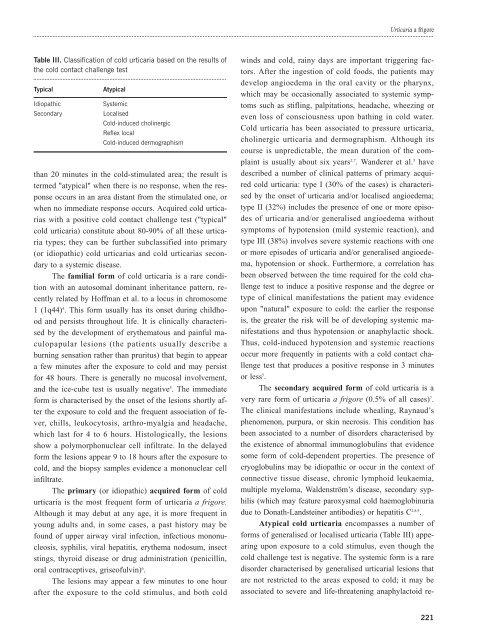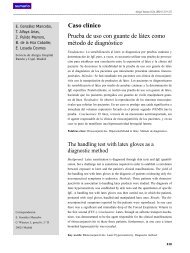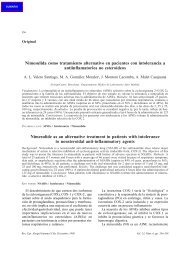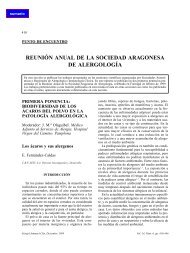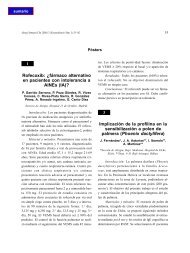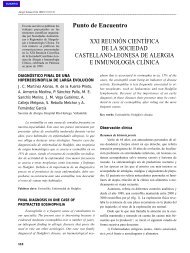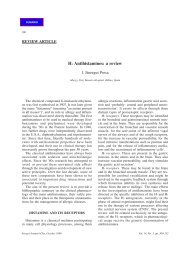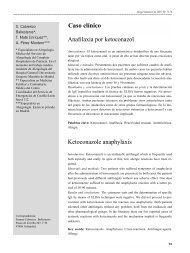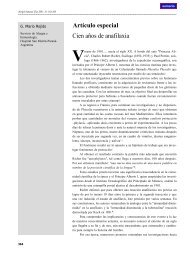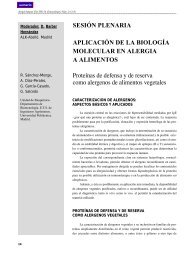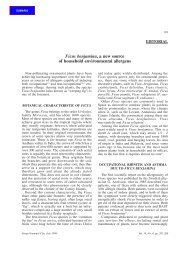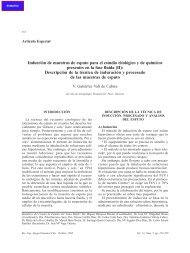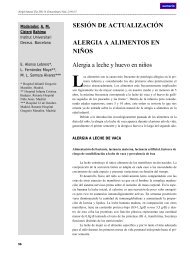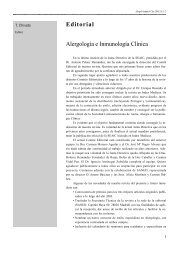a frigore - Alergología e Inmunología Clínica
a frigore - Alergología e Inmunología Clínica
a frigore - Alergología e Inmunología Clínica
Create successful ePaper yourself
Turn your PDF publications into a flip-book with our unique Google optimized e-Paper software.
Table III. Classification of cold urticaria based on the results of<br />
the cold contact challenge test<br />
Typical Atypical<br />
Idiopathic Systemic<br />
Secondary Localised<br />
Cold-induced cholinergic<br />
Reflex local<br />
Cold-induced dermographism<br />
than 20 minutes in the cold-stimulated area; the result is<br />
termed "atypical" when there is no response, when the response<br />
occurs in an area distant from the stimulated one, or<br />
when no immediate response occurs. Acquired cold urticarias<br />
with a positive cold contact challenge test ("typical"<br />
cold urticaria) constitute about 80-90% of all these urticaria<br />
types; they can be further subclassified into primary<br />
(or idiopathic) cold urticarias and cold urticarias secondary<br />
to a systemic disease.<br />
The familial form of cold urticaria is a rare condition<br />
with an autosomal dominant inheritance pattern, recently<br />
related by Hoffman et al. to a locus in chromosome<br />
1 (1q44) 4 . This form usually has its onset during childhood<br />
and persists throughout life. It is clinically characterised<br />
by the development of erythematous and painful maculopapular<br />
lesions (the patients usually describe a<br />
burning sensation rather than pruritus) that begin to appear<br />
a few minutes after the exposure to cold and may persist<br />
for 48 hours. There is generally no mucosal involvement,<br />
and the ice-cube test is usually negative 5 . The immediate<br />
form is characterised by the onset of the lesions shortly after<br />
the exposure to cold and the frequent association of fever,<br />
chills, leukocytosis, arthro-myalgia and headache,<br />
which last for 4 to 6 hours. Histologically, the lesions<br />
show a polymorphonuclear cell infiltrate. In the delayed<br />
form the lesions appear 9 to 18 hours after the exposure to<br />
cold, and the biopsy samples evidence a mononuclear cell<br />
infiltrate.<br />
The primary (or idiopathic) acquired form of cold<br />
urticaria is the most frequent form of urticaria a <strong>frigore</strong>.<br />
Although it may debut at any age, it is more frequent in<br />
young adults and, in some cases, a past history may be<br />
found of upper airway viral infection, infectious mononucleosis,<br />
syphilis, viral hepatitis, erythema nodosum, insect<br />
stings, thyroid disease or drug administration (penicillin,<br />
oral contraceptives, griseofulvin) 6 .<br />
The lesions may appear a few minutes to one hour<br />
after the exposure to the cold stimulus, and both cold<br />
Urticaria a <strong>frigore</strong><br />
winds and cold, rainy days are important triggering factors.<br />
After the ingestion of cold foods, the patients may<br />
develop angioedema in the oral cavity or the pharynx,<br />
which may be occasionally associated to systemic symptoms<br />
such as stifling, palpitations, headache, wheezing or<br />
even loss of consciousness upon bathing in cold water.<br />
Cold urticaria has been associated to pressure urticaria,<br />
cholinergic urticaria and dermographism. Although its<br />
course is unpredictable, the mean duration of the complaint<br />
is usually about six years 2,7 . Wanderer et al. 5 have<br />
described a number of clinical patterns of primary acquired<br />
cold urticaria: type I (30% of the cases) is characterised<br />
by the onset of urticaria and/or localised angioedema;<br />
type II (32%) includes the presence of one or more episodes<br />
of urticaria and/or generalised angioedema without<br />
symptoms of hypotension (mild systemic reaction), and<br />
type III (38%) involves severe systemic reactions with one<br />
or more episodes of urticaria and/or generalised angioedema,<br />
hypotension or shock. Furthermore, a correlation has<br />
been observed between the time required for the cold challenge<br />
test to induce a positive response and the degree or<br />
type of clinical manifestations the patient may evidence<br />
upon "natural" exposure to cold: the earlier the response<br />
is, the greater the risk will be of developing systemic manifestations<br />
and thus hypotension or anaphylactic shock.<br />
Thus, cold-induced hypotension and systemic reactions<br />
occur more frequently in patients with a cold contact challenge<br />
test that produces a positive response in 3 minutes<br />
or less 5 .<br />
The secondary acquired form of cold urticaria is a<br />
very rare form of urticaria a <strong>frigore</strong> (0.5% of all cases) 7 .<br />
The clinical manifestations include whealing, Raynaud’s<br />
phenomenon, purpura, or skin necrosis. This condition has<br />
been associated to a number of disorders characterised by<br />
the existence of abnormal immunoglobulins that evidence<br />
some form of cold-dependent properties. The presence of<br />
cryoglobulins may be idiopathic or occur in the context of<br />
connective tissue disease, chronic lymphoid leukaemia,<br />
multiple myeloma, Waldenström’s disease, secondary syphilis<br />
(which may feature paroxysmal cold haemoglobinuria<br />
due to Donath-Landsteiner antibodies) or hepatitis C 2,8,9 .<br />
Atypical cold urticaria encompasses a number of<br />
forms of generalised or localised urticaria (Table III) appearing<br />
upon exposure to a cold stimulus, even though the<br />
cold challenge test is negative. The systemic form is a rare<br />
disorder characterised by generalised urticarial lesions that<br />
are not restricted to the areas exposed to cold; it may be<br />
associated to severe and life-threatening anaphylactoid re-<br />
221


